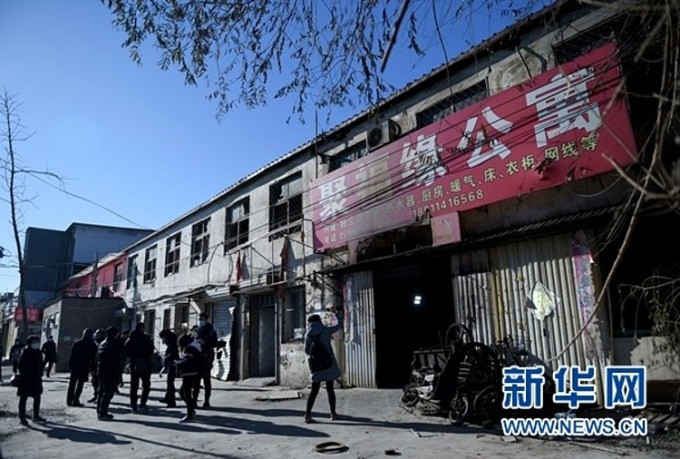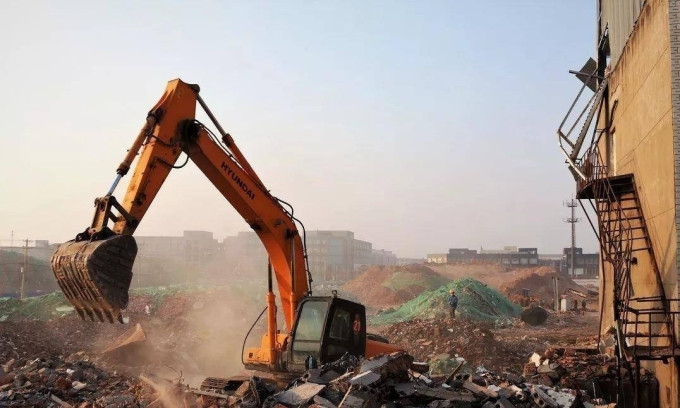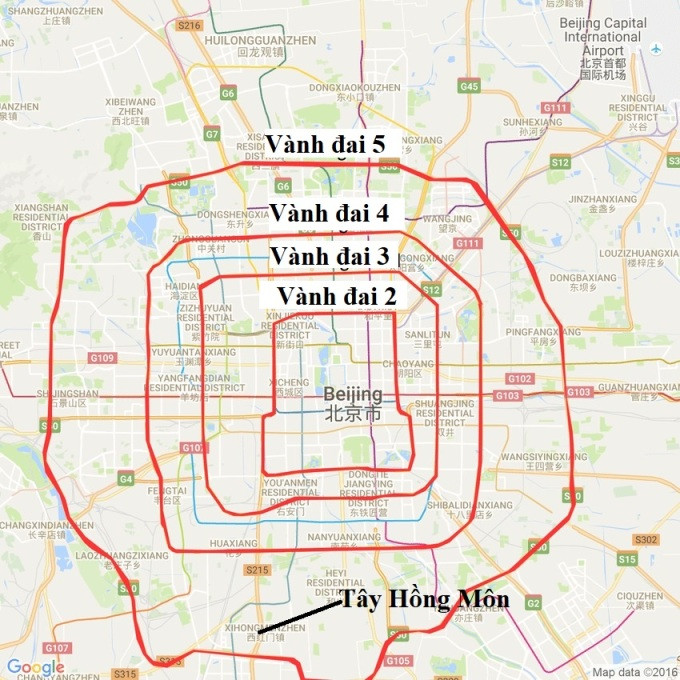The fire that killed 19 people in 2017 made the Beijing government (China) determined to relocate and renovate houses in deep alleys that do not ensure fire prevention and fighting.

On November 18, 2017, a large fire broke out in the Tu Phuc Duyen multi-functional building, which is a warehouse, factory and residential area in Tay Hong Mon, a town in Daxing District, south of Beijing, China.
The building is located on a land area of over 6,000 m2, construction area of 20,000 m2, the first basement is a cold storage, the first floor is a food court, shops, public bath, advertising sign workshop, clothing processing workshop and warehouse...
The second and part of the third floors are rental houses with a total of 305 rooms, originally planned for young families. However, they have been illegally converted into shared boarding houses, accommodating 10-20 people per room, with winding corridors and windows covered with iron frames.
The Xihongmen government took over management of the area in early November 2017 and planned to renovate and clear out the illegally built apartments on November 18, but that day fell on a Saturday so it was postponed to the following week.
The fire broke out in the cold storage in the basement of the building at 6 p.m. The Beijing Command Center received the report at 6:15 p.m. and the city's Fire Department immediately dispatched 34 fire engines and 188 personnel to the scene.
However, the building was surrounded by illegal construction, making it difficult for firefighters to reach the fire. By 9:06 p.m., they had brought the fire under control and rescued 73 people. A week later, the toxic smoke from the fire has yet to dissipate.
Investigations revealed that the fire broke out due to an electrical short circuit behind insulation in a cold storage facility under renovation in the basement. Nineteen people died and eight were injured due to carbon monoxide poisoning in the fire, all of them migrant workers from other localities, eight of whom were under 18 years old.
Just nine days earlier, a fire had broken out at a warehouse in Shunyi District, near Beijing Capital International Airport, just as US President Donald Trump was wrapping up a visit to China. Those on board Trump’s plane leaving Beijing that day likely saw a large plume of smoke rising from the burning warehouse.
The fire caused no casualties, but somewhat negatively affected Beijing's image during an important diplomatic event of the country.
After two fires, the Beijing Party Secretary and the acting mayor held a conference and launched a special 40-day campaign to inspect and clear "alley houses and deep alleys" that pose potential fire safety risks throughout the city from November 20, 2017.

The areas being inspected are known as Chengzhongcun (villages within cities). Some were once agricultural villages that became cities during China's rapid urbanization, but planning has not kept pace. Others are "slums" inhabited by migrant workers from the countryside who do not have household registration.
After the review, the Beijing government began implementing a plan to enforce demolition, demolish illegal constructions, evict tenants, and eliminate "alley houses" or places that combine housing with production facilities and factories.
To implement this determination, in addition to advocacy and propaganda measures, the city government also applied drastic policies such as cutting off electricity, water, and gas to illegally built and expanded houses. In just a few days, more than 100,000 people were forcibly relocated.
The slums were demolished and rebuilt into "urban villages" according to planning standards, ensuring fire prevention and fighting capabilities. The government also invested in building public housing areas or cheap boarding houses for low-income migrant workers.
In 2022, the Chinese government announced that it had built 6.5 million low-cost housing units in 40 cities, equivalent to 26% of the total new housing supply in the 14th Five-Year Plan (2021-2025).
Beijing’s campaign is in line with President Xi Jinping’s policy of strengthening the capital’s core competencies. During his 2014 inspection tour of Beijing, Xi called for the capital to strengthen its core functions of politics, culture, international conferences, science, technology and innovation, while moving other functions to the suburbs.
However, the campaign has also raised concerns among many who believe that the government has skipped risk assessment and expert advice steps, resulting in compensation and support not reaching the right hands of displaced migrant workers.
Experts suggest that to effectively dismantle and renovate slums in urban villages, Beijing needs to narrow the gap between urban residents and rural residents by building affordable housing and schools to make low-income people feel secure in working.
After eight years, China's view on "villages within cities" and migration has changed. In October 2023, the Ministry of Housing and Urban and Rural Development (MOHURD) of China said that in the process of transforming urban villages in China's cities and megacities, the government should plan a certain amount of social housing area, attract high-quality projects, provide a certain proportion of low-cost startup space, and ensure the startup needs of small and micro enterprises as well as individual business households.
"Take the subway to work in the city, then take the train back to the village to rest at the end of the day," China's state-run CCTV reported in a 2023 article about the living and working conditions of so-called "drifting" migrant workers in Beijing. According to CCTV, this is also a microcosm of the living conditions of people in modern-day urban villages.
A study by the Beijing Institute of Urban Planning and Design published in October 2023 showed that Beijing now has 501 "villages within the city", mainly located on the 5th and 6th ring roads, at intersections from the inner city to the suburbs and at railway stations connecting the city center to the outside.
Du Hong, an engineer at the Urban Renewal Planning Department of the Beijing Urban Planning and Design Institute, said that analysis of traffic data of 1.5 million people in more than 500 urban villages in Beijing shows that most of them move to downtown areas for work, such as Zhongguancun, a silicon valley in Haidian District in the Fourth Ring Road; the financial and economic media center in Chaoyang District between the Third and Fourth Ring Roads, etc.
In addition to recent university graduates, urban villages are also home to workers in new industries such as food delivery, ride-hailing, and content creation.

With the increasingly diverse population structure, the "natural growth" function of urban villages is also gradually perfected. Du Hong's research shows that the business sectors and public infrastructure in this area have a lower density than in the inner city, but better quality than in the suburbs. In addition, due to the small scale, business model aimed at the middle and low income group, and many young customers, so the dining, shopping and medical establishments here are easier to survive and develop.
Xinzhuang Village in Changping District is a famous urban village in Beijing whose residents are mainly programmers working for major technology companies in Guanzhong Village.
Located about a kilometer from the Shahe metro station, the village is home to 70,000 people and is surrounded by shops and a bustling night market. The cheapest rent here is 800 yuan ($110) a month. The total cost of living is around 2,500 to 4,000 yuan ($345 to $550) a month.
"At different stages of Beijing's urbanization, inner-city villages have shouldered the historical responsibility of providing basic services for urban development as well as affordable housing for low-income groups. These groups have become Beijing's new residents," said Mao Qizhi, a professor at the School of Architecture at Tsinghua University and secretary-general of the China Hundred People Urban Forum.
"For those who want to enter Beijing, Tsinghua, Renmin universities... or IT staff in Zhongguancun, these urban villages are the first places they set foot in the city during their efforts and growth," he emphasized.
Tian Li, a professor in the Department of Urban Planning at the School of Architecture, Tsinghua University, said that local governments should learn from their experience in renovating slums and old housing areas to renovate urban villages and stimulate investment, in the context of a stagnant real estate market and declining economic growth.
TB (according to VnExpress)